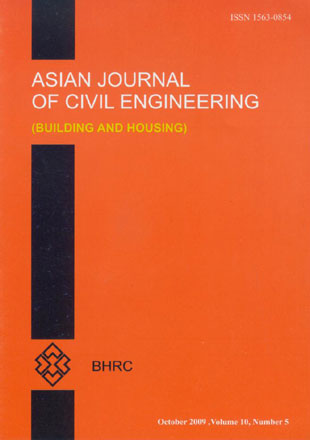فهرست مطالب

Asian journal of civil engineering
Volume:10 Issue: 5, Oct 2009
- تاریخ انتشار: 1388/08/11
- تعداد عناوین: 7
-
-
Page 495This paper reports on a full-scale experiment and numerical analysis performed to verify theearthquake resistance of a rubber ring (RR)-type U-PVC pipeline with enlarged expansionjoints for water distribution. In the experiment, one end of a buried model pipelinemeasuring 20 m in length was pulled out and/or pushed in using a hydraulic jack to simulatethe relative ground movement that occurs during the sliding of a soil mass parallel to thepipeline''s longitudinal axis. The results indicated a high level of expansion performance andslip-out prevention capability in the expansion joints. Furthermore, a high-speed loadingexperiment for the expansion joints was carried out to verify their performance againstseismic relative ground movement. The outcome clarified that the enlarged expansion jointswith slip-out prevention offer a high level of anti-seismic performance for U-PVC water supply pipelines.
-
Page 513Existing reinforced concrete buildings in north India were built at times when seismic zoneswere not recognized. These buildings need to monitor the damage and improve their loadcarrying capacities for the purpose of seismic safety. This paper investigates the effect oflateral load on the damage index of reinforced concrete frame model strengthened usingFRP sheets. Stiffness damage index and combined damage parameters approach were used.Change in modal parameters methods were investigated with the help of impact hammerexcitation test. Finally, finite element method was used for modelling, nonlinear analysisand results processing of the specimen.
-
Page 539In past earthquakes, a lot of damage occurs to the city supply systems such as electricity,gas, drinking and sewer water, telecommunications as known in the 1983 Nihonkai Chubuearthquake, 1995 Hyogoken Nambu earthquake and 2004 Niigata Chuetsu earthquake. The seismic safety of the telecommunication facilities is extremely important among otherlifelines for the disaster recovery in the emergency activities after earthquakes. Undergroundtelecommunication facilities are composed of telecommunication cables and conduits accommodating cables. In the present study, the earthquake resistance evaluation technique of underground telecommunication facilities was examined by the probabilistic method, focusing on its earthquake safety.
-
Page 549Volumetric change due to shrinkage affects performance of structural concrete thorough itsservice life. Prediction model that could be employed to estimate shrinkage after years will be beneficial for designer in analysing such effect. Unfortunately, the existing predictinmodel for example ACI 209R-92 is developed for normal weight concrete. The validity ofthe model for estimating shrinkage of lightweight aggregate concrete (LWAC) is inquestion. This research is aimed to improve ACI 209R-92 model that will be applicable forpredicting shrinkage of LWAC. For this purpose, measurement of shrinkage of LWAC up to585 days on specimens with various curing periods were carried out. ACI 209R-92 model isutilized as starting point for the prediction of shrinkage of LWAC and then shrinkage halftime value used in the model is modified to fit with the measurements. The proposed model is confirmed by the results of other investigators. It is shown that prediction of long-term shrinkage of LWAC could be improved when shrinkage half time used in ACI 209R-92 model is 65 instead of 35.
-
Page 559Endurance Time (ET) method is a new dynamic analysis procedure that aims at estimatingseismic performance of structures by subjecting them to predesigned intensifying acceleration.These acceleration functions are designed in a way that they approximately simulate earthquakes with different intensities through their duration. Performance of the structure is judged based on its behavior for different intensity measures through time. A set of three acceleration functions have been produced using the ET concept by applying optimization techniques. These acceleration functions are designed in such a way that their response spectrum, while complying with typical code design spectra, intensify uniformly with their duration. Potential applications of this method are described by evaluating the performance of sample SDOF and MDOF systems. The pros and cons of ET method are investigated. The feasibility of application of ET method as a tool in performance based seismic analysis and design is discussed
-
Page 579A solution for Laplace partial differential equation by using Spline basis functions ispresented. The formulation is derived and its differences with the finite element method are explained. The effect of some of parameters such as the knot vector and grid of control points on the solution is investigated. Finally, a few examples are presented to demonstrate the efficiency of the method.
-
Page 593Shear walls are a type of structural system that provides lateral resistance to a building orstructure and have relatively high stiffness and strength. However, since the energydissipation is made within a limited part of the shear walls, they do not exhibit ductilebehavior. Shear walls may be considered as an obstacle to make openings in the buildings.Coupled shear wall is one of the types of shear walls that has removed some of the problems encountered with shear walls. Yielding of link beams in the coupled shear walls may cause increase in energy dissipation and development of damage. Regular and uniform openings in the coupled shear walls reduce the architectural design limitations. As well as coupled shearwalls, two other types of shear walls, namely slit shear walls and shear wall with upper connection have been investigated in this paper to develop energy dissipation along with thewall height. Such shear walls concerning the architectural design limitations are lower than the normal shear walls. In this research, the above-mentioned shear walls have beenexamined under the same conditions and a comparative study has been carried outconcerning some parameters such as strength, stiffness, lateral displacement, crackingdevelopment and steel weight. Moreover, shear walls have been compared throughconsidering the ratio of strength to steel weight and their ductility and the results revealed that slit and coupled shear walls showed more favorable performance.


